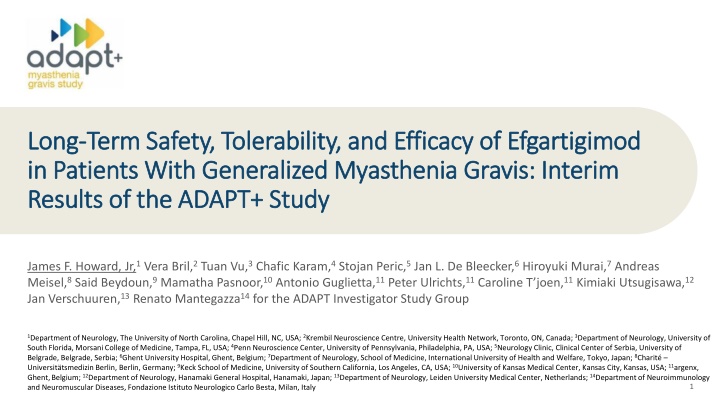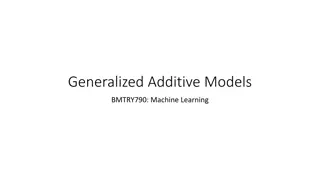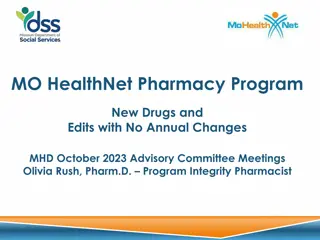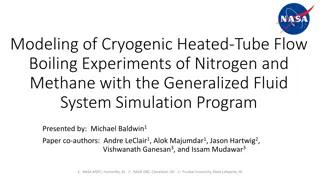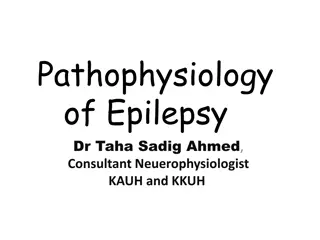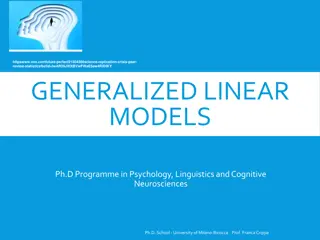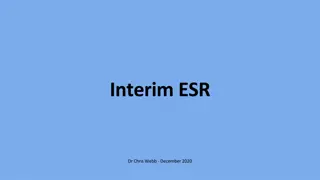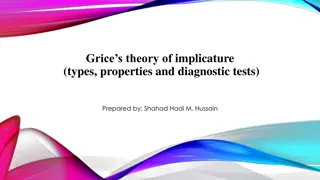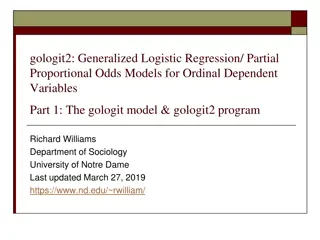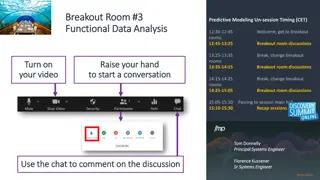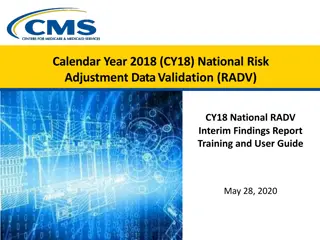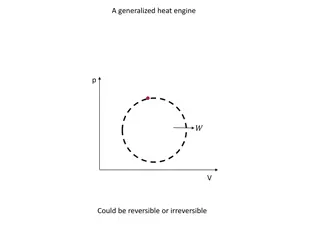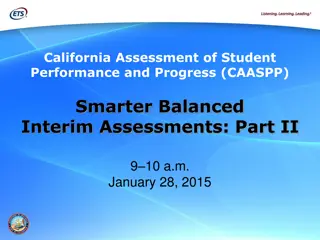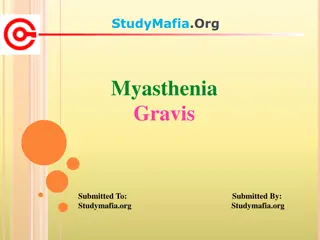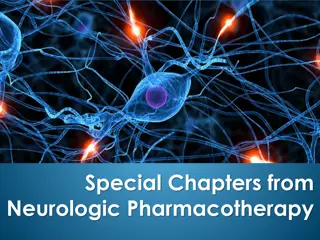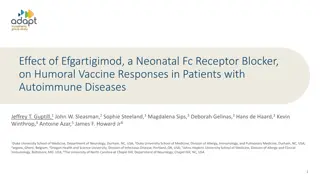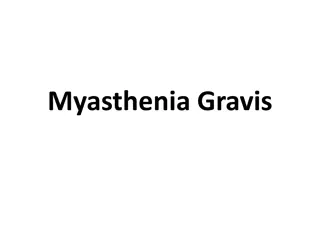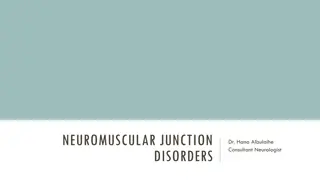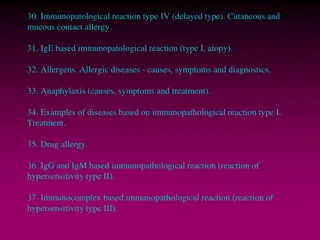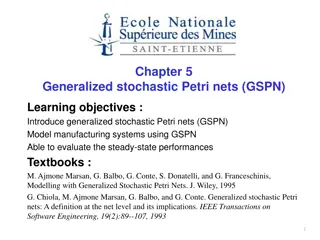Interim Results of Efgartigimod in Generalized Myasthenia Gravis
Safety, tolerability, and efficacy of efgartigimod in patients with generalized myasthenia gravis are being studied in the ADAPT+ study. The mechanism of action involves blocking FcRn to reduce IgG levels without affecting IgM or IgA. Results show promising outcomes in the treatment of this condition.
Download Presentation

Please find below an Image/Link to download the presentation.
The content on the website is provided AS IS for your information and personal use only. It may not be sold, licensed, or shared on other websites without obtaining consent from the author.If you encounter any issues during the download, it is possible that the publisher has removed the file from their server.
You are allowed to download the files provided on this website for personal or commercial use, subject to the condition that they are used lawfully. All files are the property of their respective owners.
The content on the website is provided AS IS for your information and personal use only. It may not be sold, licensed, or shared on other websites without obtaining consent from the author.
E N D
Presentation Transcript
Long Long- -Term Safety, Tolerability, and Efficacy of Efgartigimod Term Safety, Tolerability, and Efficacy of Efgartigimod in Patients With Generalized Myasthenia Gravis: Interim in Patients With Generalized Myasthenia Gravis: Interim Results of the ADAPT+ Study Results of the ADAPT+ Study James F. Howard, Jr,1 Vera Bril,2 Tuan Vu,3 Chafic Karam,4 Stojan Peric,5 Jan L. De Bleecker,6 Hiroyuki Murai,7 Andreas Meisel,8 Said Beydoun,9 Mamatha Pasnoor,10 Antonio Guglietta,11 Peter Ulrichts,11Caroline T joen,11 Kimiaki Utsugisawa,12 Jan Verschuuren,13 Renato Mantegazza14 for the ADAPT Investigator Study Group 1Department of Neurology, The University of North Carolina, Chapel Hill, NC, USA; 2Krembil Neuroscience Centre, University Health Network, Toronto, ON, Canada; 3Department of Neurology, University of South Florida, Morsani College of Medicine, Tampa, FL, USA; 4Penn Neuroscience Center, University of Pennsylvania, Philadelphia, PA, USA; 5Neurology Clinic, Clinical Center of Serbia, University of Belgrade, Belgrade, Serbia; 6Ghent University Hospital, Ghent, Belgium; 7Department of Neurology, School of Medicine, International University of Health and Welfare, Tokyo, Japan; 8Charit Universit tsmedizin Berlin, Berlin, Germany; 9Keck School of Medicine, University of Southern California, Los Angeles, CA, USA; 10University of Kansas Medical Center, Kansas City, Kansas, USA; 11argenx, Ghent,Belgium;12Department of Neurology, Hanamaki General Hospital, Hanamaki, Japan; 13Department of Neurology, Leiden University Medical Center, Netherlands; 14Department of Neuroimmunology and Neuromuscular Diseases, Fondazione Istituto Neurologico Carlo Besta, Milan, Italy 1
Disclosures Disclosures The phase 3 ADAPT and ADAPT+ studies were funded by argenx JFH has received research support, honoraria, and nonfinancial support from argenx JFH has also received research support from Alexion Pharmaceuticals, Cartesian Therapeutics, the Centers for Disease Control and Prevention (Atlanta, GA, USA), the Myasthenia Gravis Foundation of America, the Muscular Dystrophy Association, the National Institutes of Health (including the National Institute of Neurological Disorders and Stroke and the National Institute of Arthritis and Musculoskeletal and Skin Diseases), PCORI, Ra Pharmaceuticals (now UCB), and Takeda Pharmaceuticals; Honoraria from Alexion Pharmaceuticals, Immunovant Inc, Ra Pharmaceuticals (now UCB), Regeneron Pharmaceuticals, Sanofi US and Viela Bio Inc. (now Horizon Therapeutics) and nonfinancial support from Alexion Pharmaceuticals, Ra Pharmaceuticals (now UCB) and Toleranzia AB 2
Efgartigimod Mechanism of Action: Blocking FcRn Efgartigimod Mechanism of Action: Blocking FcRn FcRn recycles IgG, extending its half-life and serum concentration1 Endothelial Cell Blood Vessel Efgartigimod is a human IgG1 Fc fragment, a natural ligand of FcRn, engineered for increased affinity to FcRn2 Endosome Endothelium Efgartigimod was designed to outcompete endogenous IgG, preventing recycling, and promoting lysosomal degradation of IgG, without impacting its production2-5 Targeted reduction of all IgG subtypes No impact on IgM or IgA No reduction in albumin levels No increase in cholesterol Lysosome IgG IgG FcRn Efgartigimod (Fc Fragment) Autoantibody Antibody Image adapted from Kang TH, Jung ST.Exp Mol Med. 2019;51(11):1-9. FC, crystallizable fragment; FcRn, neonatal Fc receptor; gMG, generalized myasthenia gravis; IgA, immunoglobulin A; IgG, immunoglobulin G; IgM, immunoglobulin M. 1. Sesarman A, et al. Cell Mol Life Sci. 2010;67(15):2533-2550. 2. Ulrichts P, et al. J Clin Invest. 2018;128(10):4372-4386. 3. Vaccaro C, et al. Nat Biotech. 2005;23(10):1283-1288. 4. Howard JF Jr, et al. Lancet Neurol. 2021;20(7):526-536. 5. argenx Data on File, 2022. 3
ADAPT+ Study Design ADAPT+ Study Design ADAPT1 ADAPT+ (Open-label efgartigimod) (Placebo controlled) 2 weeks screening 26 weeks (max. 3 cycles) Up to 3 years MGFA Class II, III, IV Part A (1 y) Part B (2 y) Efgartigimod n=84 AChR-antibody positive or negative Efgartigimod Efgartigimod N=167 1:1 N=151 MG-ADL score 5a Placebo n=83 On 1 stable gMG treatmentb IgG 6 g/L 5 weeks 4 weeks Arrows indicate treatment periods of 4 infusions at weekly intervals Between treatment cycles Between treatment cycles Efgartigimod 10 mg/kg IV Placebo Subsequent treatment cycle(s) if requiredc Subsequent treatment cycle(s) if requiredc AChR, acetylcholine receptor; gMG, generalized myasthenia gravis; IgG, immunoglobulin G; IV, intravenous; MG-ADL, Myasthenia Gravis Activities of Daily Living; MGFA, Myasthenia Gravis Foundation of America; Wk, week. Note: Patients requiring rescue therapy discontinued from the study treatment. a50% of the score attributed to nonocular items. bAcetylcholinesterase inhibitor, steroid +/or nonsteroidal immunosuppressive therapy (for the duration of the trial). c Based on clinical evaluation. Patients needed to have an MG-ADL score 5 (>50% from nonocular items) and needed to have a reduction in MG-ADL total score <2 points from study/cycle baseline to be eligible to receive a new cycle. 1. Howard JF Jr, et al. Lancet Neurol. 2021;20(7):526-536. 4
Efgartigimod Demonstrated Repeatable and Sustained Improvement in Both MG Efgartigimod Demonstrated Repeatable and Sustained Improvement in Both MG- -ADL and QMG Over Multiple Cycles QMG Over Multiple Cyclesa a in ADAPT+ in ADAPT+ AChR-Ab+ Population ADL and MG-ADL Total Score Mean Change From Cycle Baseline by Cycle (Efgartigimod + current TX) QMG Total Score Mean Change From Cycle Baseline by Cycle (Efgartigimod + current TX) 0 0 Mean change ( SE) in Total MG-ADL Mean change ( SE) in Total QMG Clinically meaningful improvement -2 -2 Clinically meaningful improvement -4 -4 -6 -6 ADAPT+ Cycle ADAPT+ Cycle -8 -8 Patients Patients 106 105 99 86 74 61 102 95 85 73 61 103 95 85 71 61 103 97 81 66 57 57 49 33 22 15 106 99 83 65 49 103 93 76 54 47 101 89 73 57 48 100 89 73 55 44 90 73 59 49 40 49 38 25 15 10 1 2 3 4 5 1 2 3 4 5 99 85 72 61 0 1 2 3 7 11 Week 0 1 2 3 7 11 Week AChR-Ab, acetylcholine receptor autoantibody; MG-ADL, Myasthenia Gravis Activities of Daily Living; QMG, Quantitative Myasthenia Gravis; TX, treatment. a Only cycles with data out to week 11 are depicted 5
Cyclesa a Proportion of Patients With Increasing MG Proportion of Patients With Increasing MG- -ADL or QMG Improvement Over Multiple AChR-Ab+ Population ADL or QMG Improvement Over Multiple Cycles Change in MG-ADL Total Score Change in QMG Total Score Efgartigimod (open-label) Week 3 of cycles 1-5a in ADAPT+ median % (range) Placebo (phase 3) Week 3 of Cycle 1 in ADAPT % Efgartigimod (open-label) Placebo (phase 3) Week 3 of cycles 1-5a in ADAPT+ median % (range) Week 3 of Cycle 1 in ADAPT % 0.0% 20.0% 12.3% 0.0% 9 10 29.4% 16.0% 0.0% 8 9 0.0% 1.6% 38.9% 23.3% 0.0% 7 8 3.3% 1.7% 48.2% 28.0% 6 7 CMI (cumulative %) 9.8% 56.5% 36.0% 1.7% 5 6 68.4% 41.8% 21.3% 4 5 5.2% 31.1% 78.9% 53.0% 15.5% 3 4 85.9% 63.6% 2 45.9% 3 27.6% 6.3% 9.1% 19.7% 1 2 12.1% 13.1% 5.3% 12.3% No CMI 15.5% 0 (no change) 1 (Categorical %) 21.3% 15.5% 3.9% 6.8% Worsened 0 (no change) 29.3% 7.0% Worsened 100% 75% 50% 25% 0% 25% 50% 75% 100% 100% 75% 50% 25% 0% 25% 50% 75% 100% AChR-Ab, acetylcholine receptor autoantibody; CMI, clinically meaningful improvement; MG-ADL, Myasthenia Gravis Activities of Daily Living; QMG, Quantitative Myasthenia Gravis. a Only cycles with data out to week 11 are included.
Safety: Summary of AEs Safety: Summary of AEs Safety Population ADAPT ADAPT+ Placebo (n=83) [34.51 PY] Efgartigimod (n=84) [34.86 PY] Efgartigimod (n=139) [138.14 PY] IR/PY % (n) IR/PY % (n) IR/PY % (n) AEs 7.83 84 (70) 7.23 77 (65) 4.06 81 (112) SAEs 0.29 8 (7) 0.11 5 (4) 0.25 15 (21) 1 Infusion-related reaction event 0.26 10 (8) 0.09 4 (3) 0.09 7 (10) Infection AEs 1.22 37 (31) 1.61 46 (39) 0.84 47 (65) Discontinued study treatment due to AEs 0.09 4 (3) 0.20 4 (3) 0.07 6 (8) Severe AEs (grade 3) 0.35 10 (8) 0.29 11 (9) 0.41 19 (26) Death 0 0 (0) 0 0 (0) 0.04 4 (5) Most frequent AEs Nasopharyngitis 0.49 18 (15) 0.34 12 (10) 0.14 11 (15) Upper respiratory tract infection 0.15 5 (4) 0.32 11 (9) 0.04 4 (5) Urinary tract infection 0.12 5 (4) 0.26 10 (8) 0.09 7 (10) Headache 1.13 28 (23) 1.15 29 (24) 0.49 22 (31) Nausea 0.43 11 (9) 0.20 8 (7) 0.07 5 (7) Diarrhea 0.41 11 (9) 0.17 7 (6) 0.11 9 (12) 7 AE, adverse event; IR, incidence rate; MG, myasthenia gravis; PY, patient year; SAE, serious adverse event; URTI, upper respiratory tract infection.
Deaths in ADAPT+: None Related to Efgartigimod per Investigator Deaths in ADAPT+: None Related to Efgartigimod per Investigator Age, y/ Sex Days from last dose Cause of Death Comorbidities/Medical History Unknown; preexisting CV disease, autopsy confirmed coronary artery atherosclerosis and cardiomegaly Pulmonary embolism, chronic obstructive pulmonary disease, hypertension, hypokalemia, and colon bladder fistula 72/F 4 MG crisis and progression of underlying disease/Escherichia coli pneumonia 79/M 79 Chronic rhinitis, anxiety Histoplasmosis, asthma, diabetes mellitus, hypercholesterolemia, macular degeneration, hypertension, squamous cell carcinoma, and bundle branch block Malignant lung neoplasm (Stage IV) 66/F 60 Acute MI and generalized unspecified atherosclerosis Anemia, subarachnoid hemorrhage, CTO PCI and angioplasty procedures 55/M 24 Chronic venous insufficiency, arterial hypertension, deep vein thrombosis, rheumatoid arthritis, and paroxysmal atrial fibrillation Septic shock/ COVID-19 pneumonia 62/M 69 8 CTO PTI, chronic total occlusion percutaneous coronary intervention; CV, cardiovascular; MI, myocardial infarction; MG, myasthenia gravis; PBO, placebo; PI, principal investigator.
Distribution of Efgartigimod Complete Cycles Over 1 Year Distribution of Efgartigimod Complete Cycles Over 1 Year AChR-Ab+ population with 1 year of follow-up in ADAPT/ADAPT+ (N=88) 25 21 19 20 16 54.6% of patients received 5.5 cycles per year Patients (%) 15 12 Percent 10 8 7 5 5 8.0% 9.1% 5.7% 13.6% 18.2% 23.9% 21.6% 0 0 1 2 3 4 5 6 7 8 9 10 Nb Cycles per Year Mean: 4.87 Median: 5.21 Number of cycles per year Cycles per Year across ARGX-113-1704 and ARGX-113-1705 Cycles per year across ADAPT and ADAPT+ 9 AChR-Ab, acetylcholine receptor autoantibody.
Summary Summary The safety profile observed during long-term treatment with efgartigimod in ADAPT+ mirrored that seen during ADAPT, even while being conducted during the COVID-19 global pandemic This analysis suggests that long-term treatment with efgartigimod is efficacious, providing consistent and repeatable clinically meaningful improvement in function and strength while remaining well tolerated ADAPT+ is a planned 3-year study and is currently ongoing 10 COVID-19, coronavirus disease 2019.
Infections Occurring in 5% of Patients in ADAPT or ADAPT+ and/or More Frequentlya in Patients Treated With Efgartigimod vs Placebo Safety Population ADAPT ADAPT+ Placebo (n=83) [34.51 PY] Efgartigimod (n=84) [34.86 PY] Efgartigimod (n=139) [138.14 PY] System Organ Class (SOC) IR/PY % (n) IR/PY % (n) IR/PY % (n) 1.22 1.61 0.84 37.3 (31) Infections and Infestations 46.4 (39) 46.8 (65) 0.06 0.17 0.04 2.4 (2) Bronchitis 6.0 (5) 2.9 (4) c 0.49 0.34 0.14 18.1 (15) Nasopharyngitis 11.9 (10) 10.8 (15) 0.14 0.32 0.06 4.8 (4) 5.0 (7) URTI + viral URTI 10.7 (9) d - - 0.06 - - COVID-19 + COVID-19 pneumonia 5.8 (8) e 0.12 0.26 0.09 4.8 (4)b Urinary tract infection 9.5 (8) 7.2 (10) 0.03 0.06 0.03 1.2 (1) Gastroenteritis + viral gastroenteritis + GI infection 1.2 (1) 2.9 (4) - - 0.04 - - Herpes zoster 3.6 (5) - - 0.03 0.02 Oral herpes 1.2 (1) 2.2 (3) COVID-19, coronavirus disease 2019; GI, gastrointestinal infection; IR, incidence rate; PY, patient year; URTI, upper respiratory tract infection. aOccurring in 3 patients in the total efgartigimod group (ADAPT+) compared to placebo group (ADAPT). b 1 event was severe. c 1 event was severe. d 3 events were severe and serious. e 1 event was severe and serious. 12
Efgartigimod Demonstrated Consistent Transient Reduction in IgG Levels Over Multiple Efgartigimod Demonstrated Consistent Transient Reduction in IgG Levels Over Multiple Cycles Cyclesa a in ADAPT+ in ADAPT+ AChR-Ab+ Population Total IgG Mean % Change From Baseline Anti-AChR-Ab: Mean % Change From Baseline Mean % change ( SE) in Total Anti-AChR-Ab Mean % change ( SE) in Total IgG 20 20 0 0 -20 -20 -40 -40 ADAPT+ Cycle ADAPT+ Cycle -60 -60 Patients Patients 106 103 99 86 74 60 101 94 83 72 58 102 93 85 70 54 89 80 72 57 47 49 41 31 18 14 106 99 86 74 60 104 96 82 70 57 101 94 82 70 58 101 92 83 70 54 88 79 72 56 46 49 41 30 18 14 1 2 3 4 5 1 2 3 4 5 96 83 70 59 0 1 2 3 7 11 0 1 2 3 7 11 Week Week 13 AChR-Ab, acetylcholine receptor autoantibody; IgG, immunoglobulin G. aOnly cycles with data out to week 11 included.
Mean White Blood Cell Counts Over Time in ADAPT+ Cycles 1 Mean White Blood Cell Counts Over Time in ADAPT+ Cycles 1 5 5 Safety Population Mean Lymphocytes Mean Neutrophils Mean Leukocytes Upper limit normal 3.0 8 12 Upper limit normal 7 Upper limit normal 2.5 6 9 2.0 5 109/L (SD) 109/L (SD) 109/L (SD) 4 6 1.5 3 Lower limit normal 1.0 Lower limit normal 2 3 Lower limit normal 0.5 ADAPT+ Cycle 1 2 3 ADAPT+ Cycle 1 2 3 ADAPT+ Cycle 1 2 3 Patients 135 134 131 131 130 117 117 114 112 104 103 108 Patients 135 134 131 131 130 117 117 114 112 104 103 108 Patients 135 134 131 131 130 117 117 114 112 104 103 108 1 114 98 87 60 50 40 26 24 12 114 98 87 60 50 40 26 24 12 114 98 87 60 50 40 26 24 12 0 0 0 4 5 94 83 84 86 78 70 68 57 24 16 4 5 94 83 84 86 78 70 68 57 24 16 4 5 94 83 84 86 78 70 68 57 24 16 68 67 68 67 68 67 Week Week Week 0 1 2 3 7 11 15 0 1 2 3 7 11 15 0 1 2 3 7 11 15 14
Treatment Emergent Laboratory Abnormalitiesa Safety Population ADAPT ADAPT+ Placebo (N=83) [34.51 PY] Efgartigimod (N=84) [34.86 PY] Efgartigimod (N=139) [138.14 PY] % (n/N) % (n/N) % (n/N) Laboratory Evaluation 19.4 (14/72) 27.8 (20/72) 24.3 (28/115) Lymphocyte count decreased 5.6 (4/72) 5.6 (4/72) 3.5 (4/115) Grade 3 severity 6.3 (5/80) 13.1 (11/84) 14.6 (19/130) Neutrophil count decreased - - 0.8 (1/130) Grade 3 severity 5.1 (4/80) 12.3 (10/81) 13.3 (17/128) White blood cell decreased 1.3 (1/80) - - Grade 3 severity PY, patient year. aIn patients who entered ADAPT/ADAPT+ with normal counts in the respective parameters at study baseline 15
